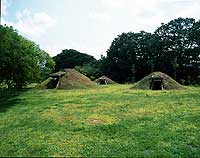
| Specified type | Country designation |
|---|---|
| Type | Historic site |
| Designated date | December 21, 1993 |
| Specified details | |
| quantity | |
| location | Ichinohe Town Iwakan character Goshono |
| owner | Ichinohe |
| Holding group | |
| Management organization | |
| home page | Ichinohe Town (visiting cultural assets in Ichinohe Town) Introduction of designated cultural assets of Ichinohe-cho |
Overview
It is located in the terrace of approximately 190m-200m in elevation close to the east of Ichinohe town city area and the east of National highway No. 4 one house bypass.
The remains are formed on the entire flat surface of the terrace, which is about 200m wide and extends about 500m in an arc from east to north.
Through excavations so far, many settlements and stone monuments have been found in the late Middle Jomon period (about 4,500 years ago).
In addition to the tombs and settlements from the Nara period to the Heian period, it was also found that it was used as a castle in the Middle Ages.
The high season of this ruins is the second half of the Jomon period, and villages begin to be run at the east, center and west of the plateau first.
Next, a large-scale construction work called "embroidery remains" is carried out in the central area, and the tomb area and stone distribution remains with the core of the square where the ritual, funeral and ceremonies of Mura are held in the center Two groups of buildings were arranged in a row concentrically.
The detected residences spread over the entire terrace in about 400 buildings, including many large ones exceeding 10m.
In addition, many artifacts such as Jomon pottery, stoneware, earthen products are also excavated.
From such a scale of the ruins, Goshono ruins is presumed to be a base remains of the Mabune River middle basin, and it is a valuable ruin in investigating the social structure of those days.
